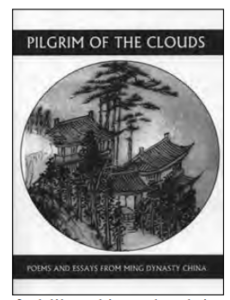BY HUNG-TAO YUAN AND HIS BROTHERS
TRANSLATED BY JONATHAN CHAVES
NEW YORK: WHITE PINE PRESS, 2005
162 PAGES, ISBN 10: 1-893996-39-5, PAPERBACK
REVIEWED BY IHOR PIDHAINY
 The re-issue of Jonathan Chaves’ Pilgrim of the Clouds, an anthology of translations of the poetry and prose of the three Yuan brothers: Yuan Hongdao (1568–1610), Yuan Zongdao (1560–1624), and Yuan Zhongdao (1570–1624), is welcome news. In its handy size (it fits comfortably into a jacket pocket or a small pocket of a knapsack), it is the perfect companion for trekkers who feel like taking a break in a tea-house (or café), or, for those of us bound to the classroom, an affordable additional text that students in an undergraduate or senior high school course will find both entertaining and instructive.
The re-issue of Jonathan Chaves’ Pilgrim of the Clouds, an anthology of translations of the poetry and prose of the three Yuan brothers: Yuan Hongdao (1568–1610), Yuan Zongdao (1560–1624), and Yuan Zhongdao (1570–1624), is welcome news. In its handy size (it fits comfortably into a jacket pocket or a small pocket of a knapsack), it is the perfect companion for trekkers who feel like taking a break in a tea-house (or café), or, for those of us bound to the classroom, an affordable additional text that students in an undergraduate or senior high school course will find both entertaining and instructive.
Professor Chaves presents the work of Yuan Hongdao, “one of the major poets and essayists of the Ming dynasty” in his characteristically fine translations. The inclusion of reproductions of a number of paintings or details of paintings from contemporary late Ming artists enriches the collection immensely and allows the reader to see the relationships between the poetry, prose, and painting of the period.
There are several types of poems here—but appropriately the greatest number are on places visited. At the end of one poem, “Returning Home at Night from Hsien-ling Shrine,” Hongdao has just returned home and “no lights are on; I yell at my servants to boil up some hot gruel. As I dash off my poem – ink covering the Wu paper – / the last raindrops splatter lightly on the bamboo beneath the eaves.” The richness of the aesthetic experience coupled with the poet’s obtuseness to those in his employment speaks of the complexities of the social and literary aspects of the late Ming. In “Climbing Mount Yang” Hongdao opens with an animal imagery description of the scenery: “Craggy rocks, crouching like elephants;/ withered pine barks, mottled like fish scales.” In “Climbing Mount Hua,” Hongdao ends with a delightful image: ‘If you come across the chessboard, stay for a while:/ before you know it, the wildflowers/ will fade/ and bloom again.’ The images are richly conveyed, and the translator nicely captures them in English.
The prose pieces are even more interesting than the poetry, including several that match poems translated earlier, allowing us to compare how poetry and prose were used to describe similar scenes. There is also a lovely paean to preserving nature—the author complains about the habit of Chinese inscribing their mountains with writing: “What crime have the green mountains and white rocks ever committed, that their face should be branded and their skin cut? Oh, how inhumane!”
The volume also includes an introduction by the translator—it is well-written, but unfortunately unchanged from its original publication in 1978, and since then, quite a lot of work has been published in English, Chinese, and other languages. Finally, there were at least a half-dozen typos in the book, and considering that the effort needed to clean them up should have not been great, there is no excuse for them still being there.

